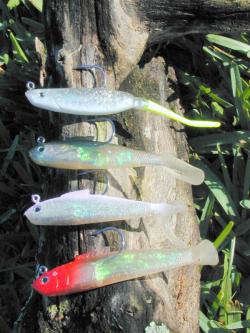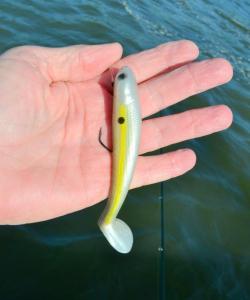Swimbait Bassing
By Frank Sargeant
from The Fishing Wire
There’s not much that better imitates a shad than a swimbait; many of them are nearly an exact imitation of the favorite food of bass in most of North America in shape, and their swimming tail closely resembles the movement of a free-swimming shad. Add to this that the soft plastic body feels edible, and the single hook is much less likely to catch weeds than the trebles of crankbaits and lipless lures and you get an idea why the swimbait is a favorite nearly everywhere in bass country.
Big swimbaits often fool big fish, winter or summer, throughout shad country.They can be particularly effective in early winter in the South and Southwest, where early freezes knock back the thickest weed stands, leaving tall but scattered springs of cover that’s prime country for swimbaiting.
Bass particularly like to prowl the scattered weed stands at the edge of deeper water; these are areas where shad congregate in winter, and anglers who motor these edges and watch their sonar will eventually find spots where there are lots of shad either on the edge or nearby. These are ideal areas to try swimbaits.
Swimbaits vary widely in size, from little 3/16 ounce models barely three inches long to big 8-inchers that would just about choke a striped bass. The best for all-around bassing are typically 4 to 6 inches long, in silver, white or steel gray colors.
Varying the weight of the jig head or the swimbait hook (some have sliding weights that pinch on the shaft) makes all the difference on the depth at which the lure runs and the speed at which you’ll want to fish it. With a light head, a big bait can only get deep if you fish it slowly, and many days in winter that’s exactly what the fish want.
Molded swimbaits like these from Bimini Bay/Tsunami are more durable than those that are designed to be fished on a bare jig head.At other times, though, the fish may be more active and you’ll do better with a slightly heavier head, allowing you to fish the bait faster and still get it down to where the fish are. At times, the best speed is dead slow, literally crawling it along bottom.
One of the nice things about these baits is that you can fish the same lure at a wide variety of depths, from just below the surface to right along the bottom, just by varying the retrieve speed.
Good swimbaits will tell you when you’re in the sweet spot for cranking speed–many of them actually cause the rod to throb as the tail wobbles back and forth. It’s a much less pronounced feel than you get with a crankbait, but it’s clearly there when you get the speed right.
Bass typically just swim up and inhale the swimbait–you’ll feel a strong bump, and that tells you it’s time to set the hook. Unlike with crankbaits, there’s less danger of pulling the hooks free with a quick hookset of the large, single hook.
The Shadalicious from Strike King can be fished over a tube jig head, making the lead invisible.
While swimbaits often work best in scattered grass at this time of year, they can also be great open-water baits when anglers find bass suspended near shad schools over the main channel. This action often occurs near the upstream tips of shell bars, and blind casting in these areas with heavier swimbait heads sometimes connects, but the best bet is to ease along watching the sonar until you spot large schools of bait, then fish those areas hard.
In open water, the retrieve that works may be a bit more aggressive–a series of pull-and-drop actions can sometimes turn the fish on when they ignore a steady retrieve.
Storm, Strike King, YUM, Tsunami and many other companies make good swimbaits–buy a variety of colors and sizes, along with a good assortment of jig head weights, and you’ve got just about everything needed for successful winter angling through the month of December in much of largemouth bass country south of Mason-Dixon.


